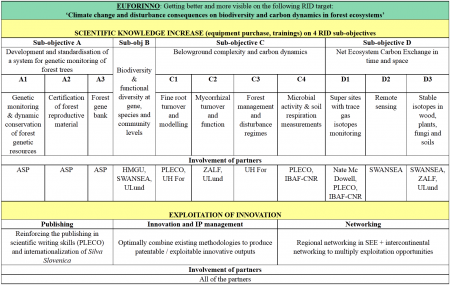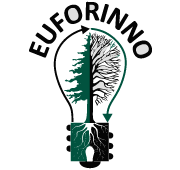| EUFORIA 2015 |
| Presentation |
| Slovenian Forestry Institute |
| Organisation of Work Packages |
| Management Structure |
| Deliverables and Objectives |
| A: Development and Standardisation of A System For Genetic Monitoring Of Forest Trees |
| B: Biodiversity & Functional Diversity at Gene, Species and Community Level |
| C: Belowground Complexity and Carbon Dynamics |
| D: Net Ecosystem Carbon Exchange in Time and Space |
| Publications |
| News/Events |
| Photo |
| Partners |
| Links |
| Contact |
D: Net Ecosystem Carbon Exchange in time and space
Problem: The application of isotopic science to forestry has been hampered by technical limitations making sampling slow, tedious and expensive, thus limiting our ability to advance in understanding ecosystem processes. High-frequency approaches, enabling higher throughput sampling at a fraction of a cost of traditional mass spectrometry, are now available to allow rapid measurements of the isotopic composition of stocks and fluxes, such as CO2, H2O, N2O and CH4. They provide novel understanding of the function of plants and ecosystems, the carbon and water cycles, and the interactions of climate and the biosphere. In addition these measurements can be used in a forensic manner to assess sources of anthropogenic contributions to atmospheric greenhouse gases. Isotopic measurements are significantly enhanced by additional measurements allowing insight into the cause and effect of observed isotopic patterns (Bowling et al., 2005; Barbour et al., 2007a,b; McDowell et al., 2008 and Shim et al., in review). In a forest setting, these measurements include continuous observations of ecosystem and soil carbon and water exchange, standard leaf, soil, and whole-tree level gas exchange measurements, observations of seasonal leaf phenology, and infrequent measurements of the stable isotope pools. Additionally, by using stable isotopes in wood it may be possible to exploit the advantages of tree ring chronologies whilst avoiding some of the problems associated with tree-ring widths or densities. A suitable way to monitor isotopes is application of super-sites.
Full-waveform LiDAR acquired accurate measurement of canopy height, vertical structure of vegetation and the aboveground biomass at a landscape and ecosystem level are essential for an overall understanding of the carbon cycles over terrestrial ecosystems in time contributing to understanding and calculation of Net Ecosystem Carbon Exchange (Griffis et al., 2004).
RID target achievement: Development of a laboratory for stable isotopes analysis including laser-based in situ methodologies for forestry development of NCEE models, upgrading of a standardised LiDAR method for acquiring data relevant for forestry.
Sub-objectives:
- D1. Super sites with trace gas isotopes monitoring: recruited senior scientist - Nate McDowell
- D2. Remote sensing
- D3. Stable isotopes in wood, fungi and soils: develop a fully established laboratory for analysis of stable isotopes of carbon, oxygen, nitrogen and hydrogen in plants, fungi and soils, and tree-ring widths or densities: recruited a specialized post-doc to run stable isotopes analyses
Collaborative partner involved: SWANSEA (D. McCaroll), IBAF-CNR (G. Matteucci), ZALF (A. Gessler), PLECO (R. Ceulemans), ULund (H. Wallander), Nate McDowell (senior scientist from Los Alamos to be employed, a specialized post-doc to run IRMS to be employed).
Expected outputs:
- D1: Trace gas stable isotopes monitoring standardized
- D2: A LIDAR application standardized over an appropriate test area
- D3: Fully established laboratory for stable isotopes analysis
The RID Strategy of SFI is illustrated in the table below

Problem: The application of isotopic science to forestry has been hampered by technical limitations making sampling slow, tedious and expensive, thus limiting our ability to advance in understanding ecosystem processes. High-frequency approaches, enabling higher throughput sampling at a fraction of a cost of traditional mass spectrometry, are now available to allow rapid measurements of the isotopic composition of stocks and fluxes, such as CO2, H2O, N2O and CH4. They provide novel understanding of the function of plants and ecosystems, the carbon and water cycles, and the interactions of climate and the biosphere. In addition these measurements can be used in a forensic manner to assess sources of anthropogenic contributions to atmospheric greenhouse gases. Isotopic measurements are significantly enhanced by additional measurements allowing insight into the cause and effect of observed isotopic patterns (Bowling et al., 2005; Barbour et al., 2007a,b; McDowell et al., 2008 and Shim et al., in review). In a forest setting, these measurements include continuous observations of ecosystem and soil carbon and water exchange, standard leaf, soil, and whole-tree level gas exchange measurements, observations of seasonal leaf phenology, and infrequent measurements of the stable isotope pools. Additionally, by using stable isotopes in wood it may be possible to exploit the advantages of tree ring chronologies whilst avoiding some of the problems associated with tree-ring widths or densities. A suitable way to monitor isotopes is application of super-sites.
Full-waveform LiDAR acquired accurate measurement of canopy height, vertical structure of vegetation and the aboveground biomass at a landscape and ecosystem level are essential for an overall understanding of the carbon cycles over terrestrial ecosystems in time contributing to understanding and calculation of Net Ecosystem Carbon Exchange (Griffis et al., 2004).
RID target achievement: Development of a laboratory for stable isotopes analysis including laser-based in situ methodologies for forestry development of NCEE models, upgrading of a standardised LiDAR method for acquiring data relevant for forestry.
Sub-objectives:
- D1. Super sites with trace gas isotopes monitoring: recruited senior scientist - Nate McDowell
- D2. Remote sensing
- D3. Stable isotopes in wood, fungi and soils: develop a fully established laboratory for analysis of stable isotopes of carbon, oxygen, nitrogen and hydrogen in plants, fungi and soils, and tree-ring widths or densities: recruited a specialized post-doc to run stable isotopes analyses
Collaborative partner involved: SWANSEA (D. McCaroll), IBAF-CNR (G. Matteucci), ZALF (A. Gessler), PLECO (R. Ceulemans), ULund (H. Wallander), Nate McDowell (senior scientist from Los Alamos to be employed, a specialized post-doc to run IRMS to be employed).
Expected outputs:
- D1: Trace gas stable isotopes monitoring standardized
- D2: A LIDAR application standardized over an appropriate test area
- D3: Fully established laboratory for stable isotopes analysis
The RID Strategy of SFI is illustrated in the table below

News
09.03.2016
4th EUFORINNO Advisory Board Meeting
will be held from 10th to 11th March 2016 at the Slovenian Forestry Institute ...
posvet METODOLOGIJE OCEN VPLIVOV TVEGANJA
14. januarja 2016 od 9. do 13. ure v dvorani Slovenske akademije znanosti ...






